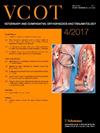正常单峰骆驼腕骨的计算机断层关节摄影
IF 1
2区 农林科学
Q3 VETERINARY SCIENCES
Veterinary and Comparative Orthopaedics and Traumatology
Pub Date : 2016-02-22
DOI:10.3415/VCOT-15-06-0112
引用次数: 5
摘要
本前瞻性尸体研究的目的是为健康单峰骆驼腕关节提供详细的计算机断层扫描(CT)参考。研究人员使用了六只看起来健康的骆驼的十二只前肢。对12例正常尸体骆驼腕关节在关节内注射碘造影剂前后进行计算机断层成像。在背侧和副矢状面重建横向CT图像。在植骨窗CT图像上,六块腕骨、桡骨滑车、掌骨近端关节面清晰可见。在软组织设置窗口的CT图像上识别桡腕、腕掌骨、横腕间、内侧和外侧腕内、腕中、腕骨副、内侧和外侧副韧带、腕管、关节囊、伸屈肌腱。对比后的CT图像提供了更好的描绘腕间韧带,囊室和窝。结果表明,CT和CT关节造影可以识别单峰骆驼腕关节的骨性和临床重要的软组织结构。本研究的CT数据将为骆驼腕关节疾病的诊断提供依据。本文章由计算机程序翻译,如有差异,请以英文原文为准。
Computed tomographic arthrography of the normal dromedary camel carpus
Summary The aim of this prospective cadaveric study was to provide a detailed computed tomographic (CT) reference of the carpal joint in healthy dromedary camels. Twelve forelimbs of six apparently healthy camels were used. Computed tomographic imaging of 12 normal cadaveric camel carpal joints was performed before and after intra-articular administration of iodinated contrast medium. Transverse CT images were reconstructed in dorsal and parasagittal planes. The six carpal bones, the radial trochlea, and the proximal articular surface of the metacarpal bones were clearly visible on CT images with the bone setting window. Radiocarpal, carpometacarpal, transverse intercarpal, medial and lateral palmer intercarpal, middle intercarpal, accessory carpoulnar and medial and lateral collateral ligaments, carpal canal, joint capsule, and the extensor and flexor tendons were identified on CT images with the soft-tissue setting window. Postcontrast CT images provided better delineation of intercarpal ligaments, the capsular compartments and recesses. Results indicated that the osseous and the clinically important soft tissue structures of the dromedary camel carpal joint could be identified using CT and CT arthrography. The CT data of this study will serve as a basis for diagnosis of carpal problems in camels.
求助全文
通过发布文献求助,成功后即可免费获取论文全文。
去求助
来源期刊
CiteScore
2.00
自引率
15.40%
发文量
49
审稿时长
18-36 weeks
期刊介绍:
Veterinary and Comparative Orthopaedics and Traumatology (VCOT) is the most important single source for clinically relevant information in orthopaedics and neurosurgery available anywhere in the world today. It is unique in that it is truly comparative and there is an unrivalled mix of review articles and basic science amid the information that is immediately clinically relevant in veterinary surgery today.

 求助内容:
求助内容: 应助结果提醒方式:
应助结果提醒方式:


